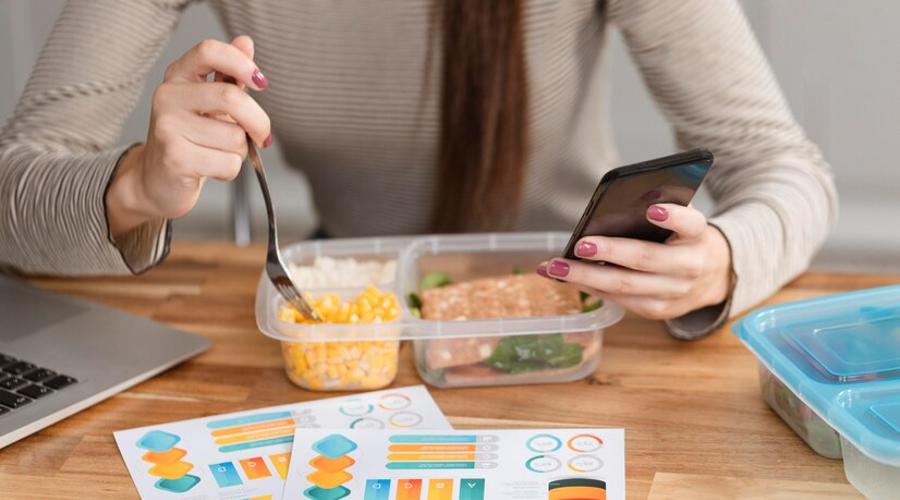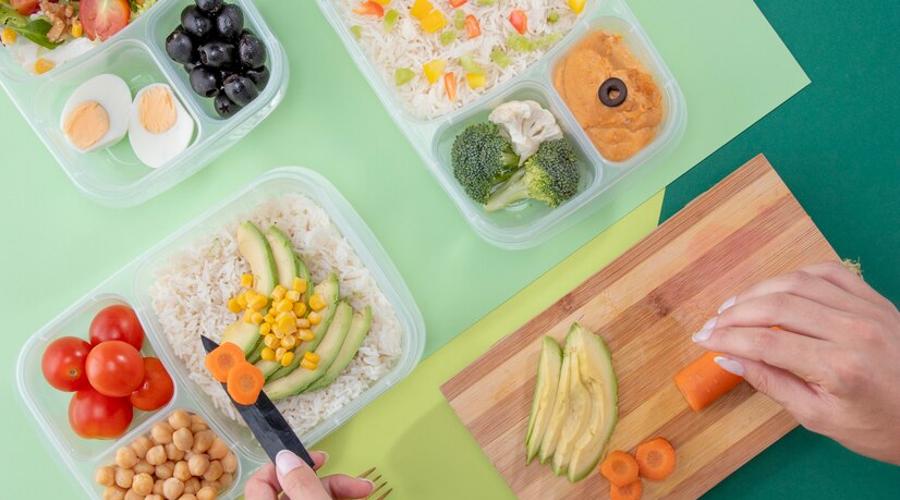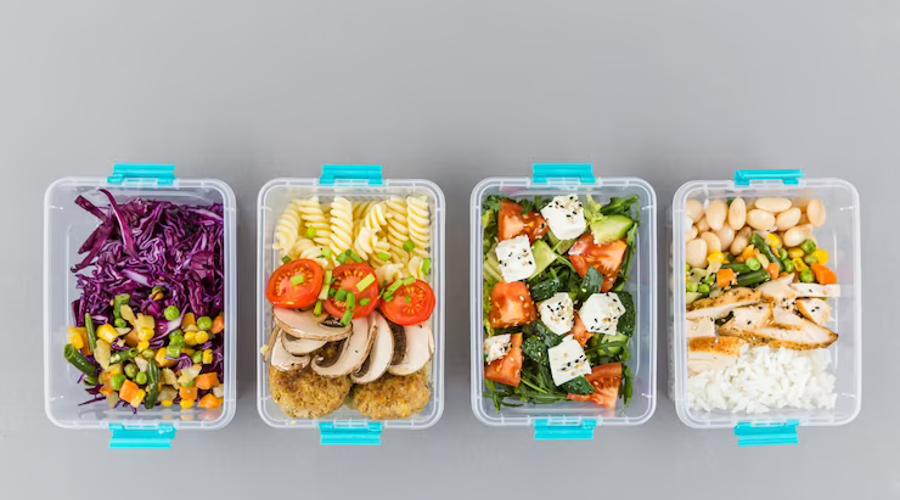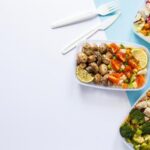Maintaining a healthy diet and lifestyle can be challenging, especially when faced with busy schedules and tempting convenience foods. However, meal prepping and calorie counting have become increasingly popular practices to help individuals achieve their health goals.
Meal prepping involves planning and preparing meals and snacks in advance, while calorie counting entails tracking calorie intake to promote mindful eating. In this article, we will provide step-by-step instructions on how to meal prep and count calories for a healthier lifestyle.

Introduction to Meal Prepping and Calorie Counting
Meal prepping and calorie counting are two effective methods for achieving weight loss and maintaining a healthy diet. Meal prepping involves preparing meals in advance, usually for the week ahead, to ensure that you have healthy and nutritious meals readily available. Calorie counting, on the other hand, involves tracking your daily calorie intake to ensure that you are in a calorie deficit, which is essential for weight loss.
Benefits of Meal Prepping and Calorie Counting
- Saves time and money: Meal prepping helps to save time and money by eliminating the need to make daily trips to the grocery store or order takeout meals.
- Helps with weight loss: By tracking your calorie intake and having pre-prepared healthy meals readily available, you can easily stick to your calorie goals and achieve weight loss.
- Promotes a healthy and balanced diet: Meal prepping and calorie counting encourages you to eat a balanced diet, which is essential for overall health and wellbeing.
Common Mistakes to Avoid When Meal Prepping and Counting Calories
When it comes to meal prepping and counting calories, there are some common mistakes that people make. One of the most significant is not accurately measuring portion sizes, which can lead to consuming more calories than intended.
Another mistake is not planning for snacks, which can lead to impulsive and unhealthy food choices. Additionally, relying too heavily on processed or pre-packaged foods can hinder weight loss goals and overall health.
Finally, it’s essential to remember that counting calories isn’t a magic solution and that it’s still important to focus on overall nutrition and balance in your diet.
Tools and Supplies You Need for Meal Prepping and Counting Calories
- Food scale: A food scale is essential for accurately measuring portions and tracking calorie intake.
- Meal prep containers: These containers are designed to hold pre-prepared meals and are available in different sizes and shapes to suit your needs.
- Calorie tracking app: There are several calorie tracking apps available, such as MyFitnessPal and Lose It!, which can help you track your daily calorie intake.

How to Plan Your Meals for the Week
Planning your meals for the week is an important part of meal prepping and counting calories. It allows you to take control of your diet and ensure that you are meeting your nutritional goals.
Determine Your Calorie and Macronutrient Needs
Before you start meal prepping, it’s important to determine your calorie and macronutrient needs. This will ensure that you’re consuming the right amount of food to meet your health and fitness goals. Use a calorie calculator to determine how many calories you need to consume each day based on your age, gender, height, weight, and activity level.
Once you have your daily calorie target, determine the amount of protein, carbohydrates, and fats you need. A general rule of thumb is to aim for a balance of 40% carbohydrates, 30% protein, and 30% fats, but this can vary depending on your goals and dietary restrictions.
Tips for determining your calorie and macronutrient needs:
- Consult with a registered dietitian or nutritionist for personalized recommendations
- Consider any medical conditions or food allergies when determining your needs
- Experiment with different macronutrient ratios to find what works best for you
Choose Your Meal Prep Day and Time
Choosing a specific day and time to meal prep can help you stay consistent and make it easier to stick to your meal plan. Pick a day and time that works best for your schedule and choose a time when you have a few hours to dedicate to meal prepping. Some people prefer to meal prep on Sundays to have meals ready for the week ahead, while others prefer to meal prep twice a week to ensure freshness.
Tips for choosing your meal prep day and time:
- Consider your schedule and choose a day and time that works best for you
- Plan your meals and snacks ahead of time to make the meal prepping process smoother
- Prep meals in bulk to save time and ensure freshness
Plan Your Meals and Snacks
Once you have determined your calorie and macronutrient needs and chosen your meal prep day and time, it’s time to plan your meals and snacks. Start by choosing a variety of healthy protein sources, carbohydrates, and healthy fats. Focus on whole, nutrient-dense foods that will nourish your body. Use online resources or cookbooks for recipe inspiration and make a grocery list of all the ingredients you’ll need.
Tips for planning your meals and snacks:
- Consider your taste preferences and dietary restrictions when choosing recipes
- Choose a variety of protein sources, such as chicken, fish, tofu, and beans
- Include plenty of fruits and vegetables for added nutrients and fiber
- Pre-portion snacks to make it easier to stick to your calorie goals
How to Grocery Shop for Meal Prep
Meal prepping requires careful planning, and a key part of that planning process is grocery shopping. Here are some tips on how to grocery shop for meal prep:
Create a Grocery List Based on Your Meal Plan
Before you head to the grocery store, make sure you have a meal plan for the week. Based on that plan, create a grocery list of all the ingredients you will need. This will not only save you time but also help you avoid buying unnecessary items and overspending. You can also use apps and websites that offer pre-made grocery lists based on specific meal plans.
Shop for Groceries on a Budget
Grocery shopping for meal prep doesn’t have to break the bank. Here are some tips for shopping for groceries on a budget:
- Buy in bulk: Buying in bulk can be more cost-effective, especially for items like nuts, seeds, and grains.
- Look for sales and discounts: Keep an eye out for sales and discounts on items you regularly use in your meal prep.
- Shop at discount stores: Discount stores like Aldi and Lidl often offer lower prices than traditional grocery stores.
- Use frozen produce: Frozen fruits and vegetables can be just as nutritious as fresh ones and are often more affordable.
Tips for Shopping for Fresh Produce and Lean Protein
When shopping for fresh produce and lean protein, here are some tips to keep in mind:
- Buy seasonal produce: Seasonal produce is often fresher and more affordable.
- Look for sales on lean protein: Lean protein sources like chicken and fish can be expensive, so keep an eye out for sales and discounts.
- Check the sell-by date: Make sure to check the sell-by date on fresh produce and lean protein to ensure that they will last for the week.

How to Meal Prep Like a Pro
Meal prepping can seem daunting, but with the right tools and techniques, it can be a time-saving and efficient way to ensure healthy eating habits. Here are some tips on how to meal prep like a pro:
Meal Prep Methods: Batch Cooking vs. Individual Meal Prep
When it comes to meal prepping, there are two main methods: batch cooking and individual meal prep. Batch cooking involves cooking large amounts of food at once, and then portioning it out into individual servings to be consumed throughout the week.
Individual meal prep involves preparing each meal separately for the week ahead. Both methods have their pros and cons, so it’s important to choose the one that works best for your lifestyle and schedule.
How to Store and Reheat Your Meals
Proper storage and reheating techniques are crucial for successful meal prepping. It’s important to invest in high-quality containers that are leak-proof and microwave-safe. When storing your meals, make sure to label them with the date and type of food. To reheat your meals, use a microwave or oven and follow the proper temperature and time guidelines.
Tips for Meal Prepping for Different Diets (Vegetarian, Vegan, Gluten-Free, etc.)
Meal prepping can be adapted to fit different diets, such as vegetarian, vegan, gluten-free, and more. When meal prepping for different diets, it’s important to consider the specific nutrient needs and dietary restrictions. Here are some tips for meal prepping for different diets:
- For vegetarian and vegan meal prep, focus on plant-based protein sources like beans, lentils, and tofu.
- For gluten-free meal prep, choose grains like rice, quinoa, and oats that are naturally gluten-free.
- For low-carb meal prep, focus on high-protein sources like chicken, fish, and eggs, and choose non-starchy vegetables like broccoli, cauliflower, and leafy greens.

How to Count Calories and Track Your Progress
Tracking your food intake and counting calories is a powerful tool for achieving your health and fitness goals. Whether you are trying to lose weight, gain muscle, or simply maintain a healthy lifestyle, knowing exactly what you are putting into your body is essential. In this section, we will discuss how to count calories and track your progress effectively.
How to Use a Food Scale and Measuring Cups/Spoons
Measuring your food portions accurately is important when counting calories. Using a food scale and measuring cups/spoons can help you ensure that you are tracking your calorie intake correctly. Here are some tips for using these tools:
- Invest in a digital food scale that allows you to weigh your food in grams or ounces.
- Use measuring cups and spoons to portion out foods like cereal, oatmeal, and nut butter.
- Be consistent in your measurements – use the same measuring cup or spoon each time.
- When measuring liquids, use a clear measuring cup with markings on the side.
Best Apps and Tools for Counting Calories and Macros
There are many apps and tools available to help you track your food intake and count calories and macros. Some popular options include:
- MyFitnessPal: A free app that allows you to track your food intake and exercise, set goals, and connect with friends for accountability.
- Fitbit: A wearable device that tracks your activity levels, heart rate, and calories burned. It also syncs with the Fitbit app to track your food intake.
- Cronometer: A nutrition tracking app that allows you to track your food intake, water consumption, and exercise. It also tracks micronutrients like vitamins and minerals.
Tips for Staying Accountable and Motivated
Staying accountable and motivated is key to success when counting calories and tracking your progress. Here are some tips to help you stay on track:
- Set realistic goals and track your progress regularly.
- Find a workout partner or accountability buddy to keep you motivated.
- Reward yourself for reaching milestones along the way.
- Don’t beat yourself up if you slip up – just get back on track the next day.
- Remember that progress takes time – be patient and consistent with your efforts.
FAQ
Meal prepping can be a cost-effective way to maintain a healthy diet. By planning and preparing meals in advance, individuals can save money on groceries and dining out. Stick to basic ingredients and shop for sales to keep costs down. Consider buying in bulk and freezing meals for future use.
While counting every calorie can be beneficial for weight management, it’s not necessary for everyone. Focus on making healthy choices and being mindful of portion sizes. If you find counting calories too stressful, consider using portion-control containers or focusing on nutrient-dense whole foods.
Prepped meals can typically be stored in the fridge for 3-4 days and in the freezer for 2-3 months. Be sure to label your meals and snacks with the date and contents for easy identification.




